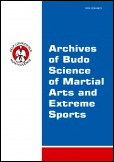2020, Volume 16, Issue 1
The impact of motor predispositions in cadets upon the results of the execution of Aviation-Synthetic Efficiency Test
Zbigniew Wochyński1, Justyna Skrzyńska-Rękawek2, Piotr Pilaczyński3, Zdzisław Kobos4
1Department of Air Transport Safety, Polish Air Force Academy, Dęblin, Poland
2Polish Air Force Academy, Dęblin, Poland
3Student Research Group - Mental and Physical Preparation for Flights, Polish Air Force Academy, Dęblin, Poland
4Department of Psychology of Work and Stress , Cardinal Stefan Wyszynski University in Warsaw, Warsaw, Poland
Author for correspondence: Zbigniew Wochyński; Department of Air Transport Safety, Polish Air Force Academy, Dęblin, Poland; email: zbigniew.wochynski@op.pl
Full text
Abstract
Background and Study Aim: Motor skills are the basis for the selection of cadets for extreme environmental conditions for the pilot’s work. Modern military equipment requires an increase in the physical and operator performance from the pilots. Therefore, the Aviation Synthetic Efficiency Test (ASET) was developed, playing a practical role in the evaluation of a physical preparation of pilots and their selection for aviation. The authors assumed that a significant number of cadets who demonstrated endurance – strength skills should achieve the highest speed of executing ASET, which could confirm the diagnostic function of the test dedicated for selection purposes in aviation. In the paper, the authors formulate a hypothesis that ASET timing depends upon motor skills in cadets, including somatic qualities.
Material and Methods: The investigation involved 59 male cadets at the average age of 21 years, studying in the first year of the aircraft pilot course. The average body weight of the examined persons equals 73.8 kg. The cadets were divided into two body weight groups: up to 73.8 kg – group A (n + 30) and above 73.8kg – group B (n = 29).
Results: The average body weight, body height and BMI were statistically significantly different among the examined groups. There was no statistically significant difference among the examined groups in the endurance tests. In the examined groups, was cadets with the following motor skills: endurance-strength type (En-St), endurance-speed type (En-Sp), speed-strength type (Sp-St), speed type (Sp), strength type (St) as well as endurance type (En). The examined persons who had only one dominant motor skill was had poorer results in ASET execution than those with double motor skills, e.g. endurance-strength. Better results were found in cadets with single skills rather than in those with double skills in only two cases. In eleven cadet pilots, the authors found double motor skills of three motor types: En-Sp, En-St, Sp-St.
Conclusions: The speed in ASET execution by the examined persons is closely related to their motor skills (predispositions), which undoubtedly exerts a tremendous practical role in the selection of pilots for military aviation. The investigation demonstrated that in the group of all examined cadets, En-St reached the highest average speed in the execution of ASET, which confirms the usefulness of this test for the selection of future military pilots. In group A the highest speed in ASET execution was achieved by the endurance-speed type, whereas in group B it was achieved by the speed-strength type, which indicates that somatic qualities may be closely related to motor skills.
Key words: multidimensional test, motor skills, electromyography, survival





